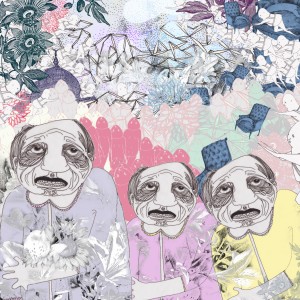Hippo Campus is the solo project of Makan Negahban, who also plays with a band called Blips. With the EP “Glass” he has created music that is at once ambient, glitchy, trippy, deep and mysterious. Laden in echo the songs seem to emerge from a distance, shrouded in haze, but not directionless. On the contrary the songs carve out a path that may seem like it is leading the listener astray into unknown, bewildering territory, but after the trip is over we find that we are safe and sound, right where we began.
The opening track “Ghosts” is a very frightening opening track, despite all of its subtleties. Chimes sound, pitch shifted, a voice calls out, synths jitter off in the distance and the whole intro seems very unsettling. You immediately find yourself in a different world from the one that you were in only seconds before the music began. The next track “Juice” seems to me to be the real kick-off to the EP, with it’s steady back beat of drums and a pumping bassline. We have wandered out of the ambient territory of the opening, to a track that is much more reminiscent to Crystal Castles, though there is something rather interesting that happens in this track with the tempo shifting that pushes and pulls at the driving element of the song. We are caught between the two sound-worlds presented so far. Ambience vs. IDM. Yes, it’s true, according to Hippo Campus, we can have both.
In “Syrup Seas” we are moving back towards ambience, though some pulsations remain that seem to want to burst through the surface. Lighter bits of percussion and synth that are really hollow and reedy sounding like pan-pipes are combined with ethereal vocals that are off in the distance. The vocals are so delayed and echoed that they seem to plead, if lazily, for attention before reinterpreting the synth line until the distant calls of the vocals are the only thing that is left.

At the center of the album is “Glass Eye, Glass Palace”, the longest and most developmental track. It seems to build in a steady crescendo until the very last second before it explodes into “Nasty Drip” which flies excitedly, continuing the trajectory of steady rising before it gets caught up in a loop. Some more distant vocals are introduced before fading off into the gently pulsating organ timbre of “Vanish, Famish, Banish and Squid”. These tracks are best experienced as a trilogy. They seem to flow into and out of each other. They create a connective tissue at the heart of the album that ties many disparate elements together. Towards the end of the trilogy there is a steady drumbeat once again, accentuated with syncopated cymbal work.
The last two tracks also seem to go together. “Pet Shamoo” drifts more towards the brand of IDM that is present in the recordings of Doormouse. “Charlemagne” comes straight out of the preceding track with the hum of angry bees and adds a depth of sound that we have not heard yet, the sounds of the deep, low pulse of a gamelan.
The album was completed earlier this year with Negahban as the sole contributor. At work in Orange County, California with only an old Casio keyboard and his laptop he created music inspired by Broadcast, Ariel Pink, Animal Collective, and Kate Bush’s “Hounds of Love”, with of course The Beatles for good measure. These varied influences helped to create an album that is layered and far reaching. Bleak and emotional, this is music that taps into a realm not often explored in music.
Work on his next project is “50-60% done” though other projects are currently in the works so there is no real definite release date. Thankfully this release is available for free over at Rack and Ruin Records. So feel free to head over there and grab the album. The artwork was done by Miranda Darley. Of her work Negahban comments that,“What stood out to me is those anguished old faces; I really liked how they are bleak, emotional, and almost humorous all at the same time, and in a way i see a lot of those same qualities with my music.It’s clear that the album, from track to track and from artwork to inception, is a whole piece of art. Everything is connected and elements are brought together to complete a total vision. Definitely worth a listen.

